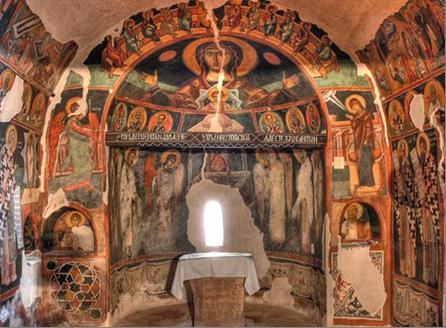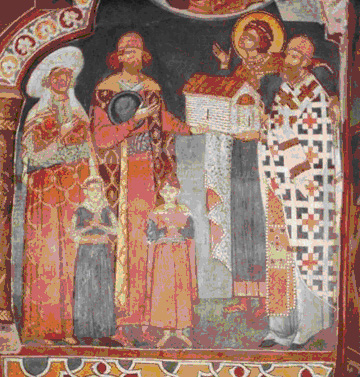
Reserved Area
Artists - ArtWorks
Church at the Kremikovtsi Monastery and its Portraits
 Bulgaria
BulgariaThe Turnovo Art School
Art Period: follows the spirit of the Tarnovo art school. Certain sources state that in 1493, with the blessing of bishop Kalevita, the rich boyar Radivoj got permission to restore the old church St. George of the Kremikovtsi monastery. During the conquest of Sofia by the Turks in 1382, they destroy the monastery built during the second Bulgarian kingdom, first ktitor of which was Tsar Ivan Alexander. Boyar Radivoj restored and decorated the church in memoriam to his children Todor and Dragana who died during the epidemics of 1492. The burial of these children was discovered during excavations in 1987.
It was founded during the 14th century, again probably due to Tzar Ivan Alexander, when 14 monasteries known as the "Sofia Mount Athos", were erected around Sofia. Destroyed in 1382, it was among the first monasteries to be restored later - in 1493 the buildings were restored, and St. George's Church erected, the sole survivor today. On the outside, the church is small and insignificant, like all the "semi-legal" buildings of those dark times. As compensation however, the murals (partially preserved today) turned the interior into a glittering gallery. The spirit of the aristocratic Turnovo School is alive here.
The falling of Bulgaria under Ottoman yoke at first stops the development of Bulgarian art culture. During the second half of the 15 century however starts a period of certain political and economic stabilization of the Bulgarian population and an upheaval of the monasteries mainly in southwestern Bulgaria. This creates an impulse for the big art traditions of Tarnovo art school /13 – 14 century/. The link presented underneath leads to an article by a Macedonian researcher, according to which the artists from the Kremikovtsi monastery are representatives of the Kostur art school.
The complex consists of two perpendicular residential buildings, an old church and a new church. No doubt, the older church, which represents a relatively small, oblong building, is of the biggest interest in terms of its historical value. The church was built in 1493 (later renovated in 1611) and it is that period that its frescoes date to. Most of the wall paintings have been (and are still being) restored to survive to present days. These are created entirely in tune with the Bulgarian tradition of the Middle Ages. The bulk of the frescoes are painted against a dark background, against which the images of saints stand out. The composition with the church’s patron, St George, on top of a white horse with his long spear stabbed into the dragon, is particularly impressive. One can notice differences in the styles of the wall paintings in the entrance and the main hall, which suggests the contribution of various artists to the internal decoration. The new church (1902) is a nicely looking building, which keeps the relics of the monastery – The Кremikovtsi New Testament of the Middle Ages (1497) with beautiful calligraphic scripts, and a wooden iconostasis dating back to the 17th century. The residential buildings, which are more than 250 years old and the foundation of which represents a simple construction of intertwined branches, were entirely repaired in the last few years. This monastery is considered to be one of the most valuable cultural monuments of the Middle Ages to be found on the Balkan peninsula. The Kremikovtsi monastery, named St George, is located about 3km away from the quarter of Kremikovtsi, up in the lower parts of the Balkan mountain.
The coloring is respectfully solemn, the drawing elegant, to the point of exquisiteness, the figures are lofty and exalted. The artists of the Kremikovtsi Church were no blind imitators of traditional methods. In the overall composition of the murals, they introduced a new element, which renewed the art of the time, and became traditional. This is the richly ornamented frieze of the waist-length figures of saints and martyrs, introduced for the first time, which separated the "classic upright saints" from subject scenes diversifying and enriching the general picture. Kremikovtsi Monastery also contains some valuable examples of calligraphic art, which was particularly perfected here during the 15th century, when the Sofia School of Literature was created and developed at Dragalevtsi, Kremikovtsi, Kokalyane, German and other monasteries. The so-called Kremikovtsi Gospel is an example of it. This cloister also dates back to the Second Bulgarian State – it is believed that the monastery was built at the time of Ivan Alexander. In 1382, when the Ottoman troops conquered the city of Sofia, the monastery was completely ruined. 111 years later, however, it was entirely reconstructed.
The most important part of the mural decorations has the group ktitor portrait – eastern part of the northern wall of the antechamber. Radivoj is presented not simply as a ktitor, but as a man honored to make contact with God. Together with Radivoj, his wife and their two diseased children – Todor and Dragana –presented is also the Sofia bishop Kalevit. Instead of a schematic ktitor scene a unique genre painting, which is found in no other church of that time in Bulgaria, is created. When presenting secular faces the artist is demonstrating strong realism. He pays special attention to the coloring and beauty of the garments of that time.
In accordance with all the considered characteristics by means of comparative analysis, we assume that the anonymous master could be an individual who belonged to the painting workshops which are credited for painting the church of St. Nicholas of the nun Eupraxia in Kastoria. We suppose the painter worked in Brajčino soon after the year 1486 and before 1493, when the decoration of the church in Kremikovci was completed, in which he most likely took part as a member of another large workshop. Regarding the question about the origins of the style of the 'master from the 1480’s', the paper articulates an opinion that they should be traced not only in the long painting traditions of Kastoria and Ohrid, but also in the collaboration of the masters and the spread of their works in these two important centers of the Ohrid Archbishopric.
Wall paintings from the late 15th century in the Monastery church of St. Paraskeve - Brajčino
Popovska-Korobar Viktorija
The Monastery of St. Paraskevy is located above the village Brajčino, on the east shore of Lake Prespa in the Republic of Macedonia. In accordance with the incomplete donor’s inscription this one-aisle church with a pitched roof was built and decorated at the same time. Reparations came around 1800, when rebuilding was done on the longitudinal walls and the narthex (without fresco decoration). The fresco paintings from the 15th century are preserved on the west facade, and on the east and west wall of the naos. The decorative program in the interior was common for the small type monastery churches without narthex. From the old edifice, on the corner of the outside southwest wall visible are remains of figures, a monk and a man in laymen’s attire facing eastward.
The iconographic program of the west facade is interesting for the scenes which encompass the patrons niche: a reduced Last Judgment (Royal Deesis, Hell and Paradise, where the monk Pahomios above the gate is depicted in prayer) and the equestrian figures of St. George and St. Mena. A parallel for the rare iconography of St. Mena with the tamed beasts is found in an unpublished icon, which most probably was painted in the last quarter of the 15th century, and is kept presently on the iconostasis of the church of Panagia tou Apostolaki in Kastoria.
The presented scene in this portrait does not fall within the themes presented in the rest of the monastery and for the first time in Bulgarian art instead of a schematic scene we have a genre painting.
Encyclopedia of visual arts in Bulgaria, volume І, A – L. Sofia, Bulgarian academy of sciences, 1980, pages 483 – 484.
Georgi Chavrukov. Bulgarian monasteries. Sofia, 1978, pages 184 – 192.
Monasteries in Bulgaria: An album. - Sofia: Spectrum, 1994.
http://www.pravoslavieto.com/manastiri/kremikovski/index.htm
http://www.trekearth.com/gallery/photo741847.htm
http://news.webshots.com/album/256976780Jbivmc
http://kdecheva.com/cmgallery/thumbnails.php?album=lastup&cat=-28
http://sic.mfa.government.bg/images/content/966/catalog%20-%20eng.pdf â the orthodox tradition of Bulgaria â very good document, with lotâs of information, details, good visual representations
http://en.journey.bg/bulgaria/bulgaria.php?guide=555 â journey BG info
http://www.bulgarian-monasteries.com/archive/kremikovci_monastery.html
http://www.bulgarianmonastery.com/kremikovtsi_monastery.html
Related Material:
Image available

File name: 17_15 century image 2.JPG
Description of the material:
Frescoes in the old monastery church of St George the Victorious, from 1493 year. Photo: Angel Iordanov
Contextualisation Of the source:
The presented mural is not supported by further reading or visual materials. It is a part of the private photo gallery of Angel Iordanov at www.trekearth.com.
Interpretation of the source:
This is a very good example of how the artist achieved exceptional heights when decorating the church. The realism of the faces, the focus of detail, coloring and garments is quite visible in this image.

File name: 17_bg - xvi - Ktitor Radivoj.jpg
Description of the material:
Ktitor Radivoj with his wife and their two children. Photo: Albena Vacheva
Contextualisation Of the source:
The presented mural is supported by reading materials and other images in the article on the monastery, which can be found at: http://www.pravoslavieto.com/manastiri/kremikovski/index.htm
Interpretation of the source:
Painted on the eastern part of the northern wall of the antechamber. Radivoj is presented not simply as a ktitor, but as a man honored to make contact with God. Together with Radivoj, his wife and their two diseased children – Todor and Dragana –presented is also the Sofia bishop Kalevit. Instead of a schematic ktitor scene a unique genre painting is created. When presenting secular faces the artist is demonstrating strong realism. Special attention is paid to the coloring and beauty of the garments of that time.
Comments about this Artist/ArtWork
Michelangelo - Copyright 2008 - This project has been funded with support from the European Commission